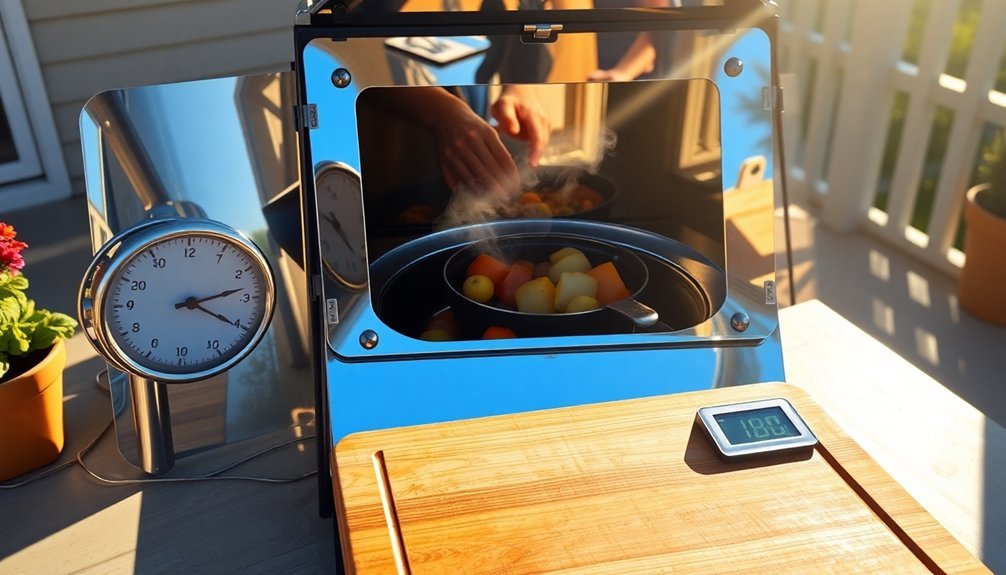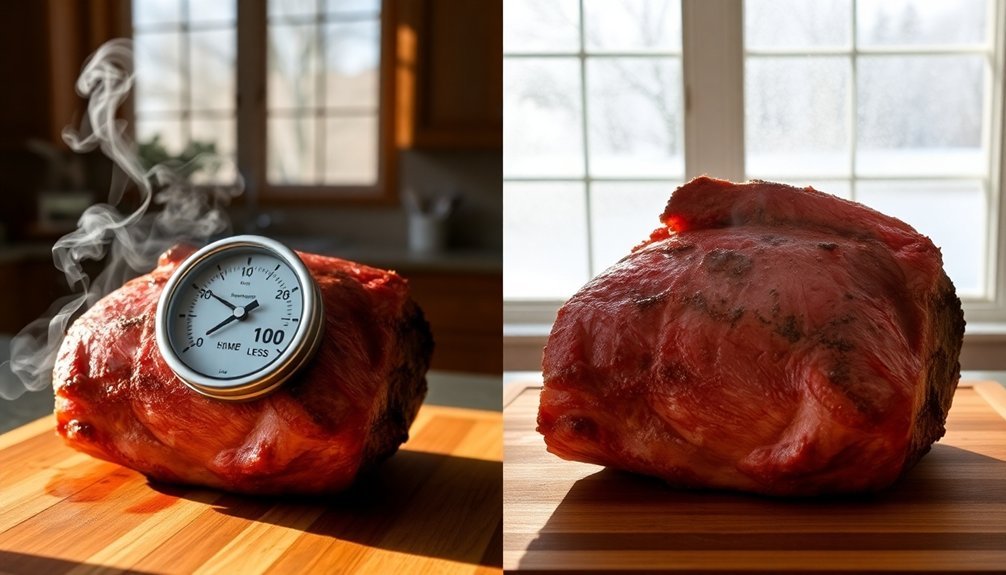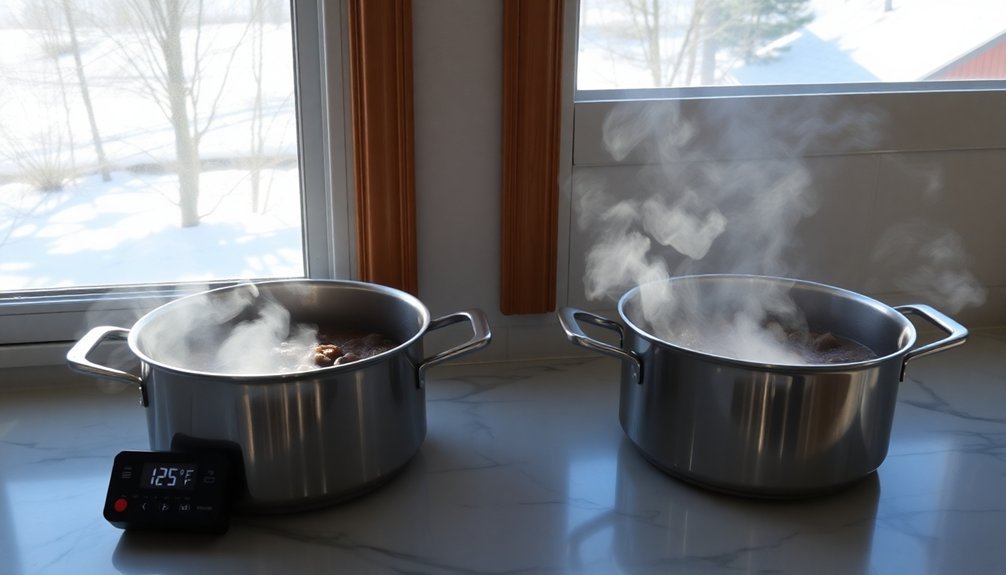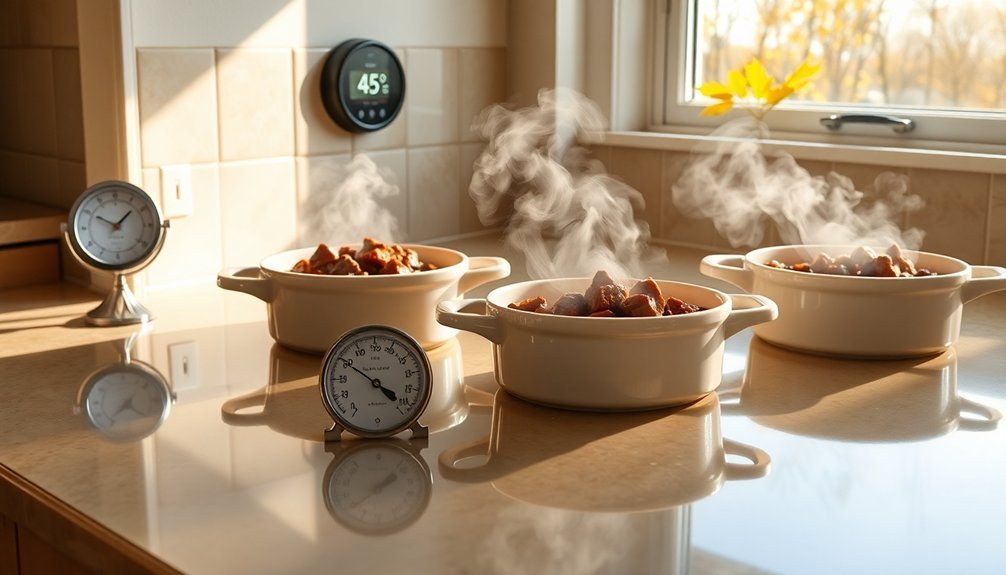You'll need to adjust your cooking times based on seasonal changes throughout the year. In summer, take advantage of peak sunlight hours between 11 am and 3 pm for ideal solar cooking, while winter requires pre-heating and more frequent repositioning due to shorter days. High humidity slows cooking times and needs 10% less liquid in recipes, while wind can disrupt heat distribution. Temperature fluctuations between seasons affect cooking speeds – summer heat accelerates the process, while winter cold extends it. Cloud cover and seasonal moisture levels in ingredients also impact your timing. Understanding these seasonal factors will help you master the art of year-round cooking precision.
Summer Solar Cooking Times

When summer arrives, solar cooking becomes an efficient and eco-friendly way to prepare meals.
You'll find the best cooking window between 11:00 am and 3:00 pm, when the sun's rays are most intense and direct. During these peak hours, your solar oven can reach temperatures of 250°F to 350°F, making it perfect for baking breads and cooking hearty dishes like ratatouille or enchiladas.
In summer, you won't need to adjust your oven's position as frequently since daylight hours are longer and sunlight is stronger. Using a dark, thin-walled pot helps convert sunlight into heat energy more efficiently.
To maximize efficiency, use dark-colored metal pots and preheat your solar oven before adding food.
Remember that while cooking times are longer than conventional methods, summer's intense sunlight helps maintain consistent temperatures, especially if you're cooking in sunny regions like Southern Arizona or Texas.
Winter Daylight Adjustments
You'll need to adapt your cooking schedule during winter months when daylight hours are greatly reduced, often limiting solar cooking to a brief window between 11:00 am and 3:00 pm.
Your cold-weather preparations should include earlier start times around 10:00 am for proper preheating and ingredient browning, with more frequent adjustments to maintain ideal sun exposure.
During particularly short days, you might split cooking tasks across multiple days to guarantee proper food preparation despite limited sunlight.
Consider using thermal storage methods to help continue the cooking process when direct sunlight becomes unavailable during shorter winter days.
Sunlight Impact on Timing
Since daylight hours drastically decrease during winter months, you'll need to adjust your cooking schedule to accommodate the reduced natural light.
In regions with extreme seasonal variations, like Barrow, Alaska, you'll find this particularly important as the sun may remain below the horizon for extended periods.
You'll notice that reduced sunlight affects both indoor and outdoor cooking temperatures. Utilizing different shelf height positions can help offset temperature variations during winter months.
Without direct sunlight, cooking times may increase as chemical reactions like browning and caramelization slow down.
For outdoor cooking or solar ovens, you'll need to plan ahead and make significant timing adjustments.
When cooking indoors, you'll benefit from using timers and thermometers to guarantee food safety, as lower visibility can make it harder to monitor your food's progress visually.
Cold Weather Prep Changes
As winter's chill sets in, preparing meals requires strategic adjustments to both cooking temperatures and timing. You'll need to modify your cooking approach to account for lower temperatures and seasonal ingredients.
| Adjustment Type | Winter Change | Impact |
|---|---|---|
| Temperature | Lower settings | Longer cooking time |
| Shelf Position | Center placement | Even heat distribution |
| Food Spacing | More spread out | Faster cooking |
| Ingredients | Root vegetables | Slower cooking methods |
When adjusting cooking temperatures downward, calculate the percentage difference and multiply your usual cooking time accordingly. For example, if you're cooking at 400°F instead of 450°F, multiply your normal cooking time by 0.89. Remember to position dishes in the center of your oven and avoid overcrowding shelves. You'll get the best results by spreading food evenly and embracing slow-cooking methods like braising and stewing for winter ingredients.
Seasonal Temperature Impact

When cooking outdoors throughout the year, seasonal temperatures play an essential role in determining your cooking times and methods.
You'll need to adapt your techniques as temperatures fluctuate across seasons.
In summer's heat, your grill will heat faster and cook food more quickly, while winter's cold will extend cooking times and increase fuel usage.
High humidity speeds up cooking by reducing moisture evaporation, so you'll want to adjust your recipes accordingly – especially when baking outdoors. In humid conditions, reduce water in dough recipes to maintain consistency.
You can combat temperature challenges by using windscreens to prevent heat loss and keeping lids on pots whenever possible.
Remember that altitude also affects cooking times – higher elevations mean lower boiling points and longer cooking periods, requiring additional adjustments to your timing and temperature controls.
Cloud Cover Cooking Changes
You'll need to contemplate how cloud cover affects the intensity of sunlight reaching your cooking area, which can impact cooking temperatures and times throughout different seasons.
When thick clouds block direct sunlight, they can lower ambient temperatures and potentially require longer cooking times or temperature adjustments.
Understanding your local seasonal cloud patterns helps you plan ahead and modify cooking schedules, especially for outdoor or solar-dependent cooking methods.
Light Intensity Affects Temperature
Light intensity plays an essential role in kitchen temperature management, especially on cloudy versus sunny days.
When you're cooking on a bright, sunny day, you'll notice your kitchen heats up faster, requiring adjustments to your cooking process. You'll need to reduce water temperatures for dough preparation and account for increased humidity affecting flour absorption.
On cloudy days, you'll experience more stable kitchen temperatures, similar to controlled low-temperature cooking environments. This consistency can work to your advantage, particularly when preparing dishes that require precise temperature control.
You'll find it easier to maintain ideal conditions for dough rising and meat preparation. To adapt, monitor your kitchen's ambient temperature and adjust accordingly – on sunny days, reduce liquid temperatures by 10-15%, and on cloudy days, stick closer to your recipe's standard measurements.
Seasonal Cloud Patterns Matter
Building on our understanding of daily light variations, seasonal cloud patterns create distinct cooking challenges throughout the year.
You'll need to adjust your cooking times based on how clouds affect your ingredients' moisture and nutrient content.
During cloudy seasons, you're likely working with produce that's developed higher acidity levels and different sugar concentrations due to reduced sunlight exposure.
This means you might need to extend cooking times for fruits and vegetables to achieve desired caramelization or reduce acidity.
On the flip side, ingredients harvested during sunnier periods often have higher sugar content and may require shorter cooking times to prevent over-caramelization.
Watch the weather patterns closely – if you're cooking with ingredients from particularly wet or cloudy seasons, you may need to account for their higher moisture content by adjusting both cooking times and temperatures.
Weather-Based Timing Adjustments
When clouds roll in, cooking times require strategic adjustments to maintain consistent results. You'll need to extend cooking durations when using methods that rely on sunlight, as cloud cover considerably reduces solar exposure.
Monitor weather conditions closely and add extra time to compensate for reduced heat intensity.
You'll find that clouds affect moisture levels too, which can impact your cooking process. Higher humidity under cloud cover may extend drying times and alter food texture.
If you're cooking outdoors, watch for precipitation that could disrupt your plans. Consider moving indoors during heavy cloud coverage.
While clouds can help stabilize temperatures, they often keep them lower than ideal. Add a safety margin to your usual cooking times and keep tracking cloud patterns to guarantee your food cooks thoroughly and evenly.
Seasonal Ingredient Preparation

Preparing ingredients in harmony with the seasons guarantees you'll get the best flavors and textures from your dishes.
In spring, you'll want to blanch asparagus and leafy greens quickly, while lightly sautéing green garlic and spring onions to preserve their delicate flavors.
Summer calls for minimal cooking – let fresh tomatoes shine in bruschetta, and grill your corn and bell peppers for prime taste.
When fall arrives, switch to heartier preparation methods for butternut squash, sweet potatoes, and root vegetables, often incorporating them into warm, filling dishes.
Winter's brussels sprouts and root vegetables benefit from roasting, while citrus fruits can brighten heavier dishes.
Remember that each season's ingredients have unique characteristics that'll determine your cooking approach – lighter touches in warmer months, more substantial cooking methods in cooler seasons.
Solar Position Time Factors
Understanding solar position is essential for effective solar cooking since the sun's location directly impacts your cooking times and temperatures throughout the day.
You'll achieve the best results between 11:00 am and 3:00 pm when the sun is highest overhead, providing direct rays and ideal heat.
You'll need to adjust your cooking schedule based on the season. During winter months, you're working with a shorter cooking window due to the sun's lower position and less intense rays.
While summer allows for longer unattended cooking periods, winter requires more frequent repositioning of your solar cooker to track the sun. If you're cooking in winter, consider pre-heating food early and maintaining warmth later in the day.
Remember that your location matters too – higher latitudes mean less direct sunlight and longer cooking times.
Weather Pattern Effects

Weather patterns can dramatically change your cooking times, with moisture levels playing a key role in how quickly food reaches the proper temperature.
You'll need to adjust your recipe timing when high humidity slows evaporation and keeps surface heat high, while low humidity speeds up moisture loss and cools food surfaces.
During heat waves, you'll want to reduce cooking temperatures and times since your grill or oven will heat up faster and maintain temperature more efficiently.
Moisture Changes Cooking Times
When moisture levels in the air fluctuate throughout the year, your cooking times will need regular adjustment to maintain consistent results. High humidity slows down evaporation rates, which means you'll need to extend your cooking times, especially for baked goods.
You'll notice this most when making breads and pastries, as flour absorbs moisture from the air, affecting your dough's consistency.
- Reduce water in your dough recipes by 10% during humid summer months to maintain proper texture
- Monitor your dough's consistency closely, as small humidity changes can greatly impact its behavior
- Keep oven doors closed during baking, as frequent opening can drop temperatures and further extend cooking times
To compensate for moisture changes, you'll also need to adjust shelf positioning and spacing between items, as these factors influence heat distribution and cooking efficiency.
Heat Wave Recipe Adjustments
Just as moisture affects cooking times, extreme heat presents its own set of culinary challenges that require smart recipe adaptations. During heat waves, you'll want to minimize using your indoor stove and oven. Instead, opt for no-cook options like cold rolls, salads, and chilled soups.
When you do need to cook, choose quick methods like grilling outdoors, brief pan-frying, or quick blanching. You can also rely on pre-cooked ingredients and focus on small, frequent meals rather than large hot dishes.
Make hydration a priority by incorporating water-rich foods like watermelon and cucumber into your meals. Don't forget to add cooling herbs like mint and cilantro to enhance freshness.
For dessert, frozen treats like watermelon lollies offer sweet relief while keeping your kitchen cool.
Humidity Level Adjustments
Since humidity levels greatly impact cooking times and food quality, understanding how to adjust your recipes accordingly can make the difference between perfect results and culinary disappointment.
During humid conditions, you'll need to reduce liquid ingredients by about 10% to maintain proper dough consistency, as flour naturally absorbs moisture from the air. High humidity speeds up cooking times due to reduced evaporation, while low humidity slows cooking through faster moisture loss.
- In humid weather, monitor cooking times carefully to prevent overcooking, especially when grilling or using outdoor ovens.
- During dry conditions, increase liquid ingredients and expect longer cooking times to achieve desired results.
- Control your kitchen's environment by using exhaust fans, air conditioning, or humidifiers to maintain ideal cooking conditions.
Wind Speed Cooking Variables

Much like humidity's influence on cooking, wind speed can dramatically alter your outdoor cooking experience.
You'll need to make significant timing adjustments when cooking in windy conditions, as heat distribution becomes uneven and cooking times typically increase.
When you're grilling or cooking outdoors, protect your setup from strong winds by using shields or windbreaks.
You'll want to secure your equipment properly to prevent tipping, especially if you're using lightweight cooking gear.
Watch for hot and cold spots that develop as wind disrupts heat distribution around your food.
For safety, you'll need to be extra cautious about sparks and embers in windy conditions.
Consider using enclosed cooking methods and keep a fire extinguisher nearby.
Regular monitoring of your food is essential to guarantee it cooks evenly despite wind interference.
Altitude Season Considerations
While altitude affects cooking year-round, seasonal changes at higher elevations create additional variables you'll need to contemplate.
During winter months, the already-low boiling point drops even further, requiring you to extend cooking times for boiled and simmered foods beyond the standard 25% increase. You'll find pressure cooking particularly helpful during cold seasons, as it maintains consistent cooking temperatures regardless of external conditions.
- Adjust your baking strategy seasonally – winter's dry air demands more liquid in recipes, while summer's humidity affects how your doughs rise.
- Consider using higher-protein flour year-round at altitude, but it's especially vital during winter baking when dough structure is more challenging to maintain.
- In summer, you might need to reduce oven temperatures slightly from your usual altitude adjustments to prevent excessive browning and spreading.
Frequently Asked Questions
How Do Different Cooking Fuels Perform Across Seasons?
You'll find that cleaner fuels like LPG and electricity perform consistently year-round, while biomass fuels may need more attention in winter. They'll all work, but efficient fuels save time across seasons.
Do Indoor Cooking Times Vary Between Day and Night?
No, your indoor cooking times won't vary between day and night. Your oven and kitchen equipment maintain consistent temperatures regardless of the time, so you'll follow the same recipe timings day or night.
Should Recipe Serving Sizes Be Adjusted Seasonally?
You'll want to adjust recipe serving sizes seasonally since your dietary needs change throughout the year. Consider lighter portions in summer and heartier servings in winter to match your energy requirements and seasonal ingredients.
How Do Seasonal Power Fluctuations Affect Electric Cooking Appliances?
You'll notice your electric cooking appliances work harder during summer and winter peaks, causing longer cooking times and potential inconsistencies. Use them during off-peak hours to avoid power fluctuations affecting performance.
When Should Seasonal Maintenance Be Performed on Cooking Equipment?
You'll want to schedule maintenance at the start of each season. Perform spring cleaning in March, summer checks in June, fall maintenance in September, and winter servicing in December to keep your equipment running efficiently.
In Summary
You'll need to stay flexible with your cooking times throughout the year as seasons change. Consider shortening cook times during hot summer days and lengthening them in cold winter months. Don't forget to account for humidity, wind, and cloud cover when adjusting your timing. Keep an eye on local weather patterns and altitude effects, and you'll master seasonal cooking time adaptations like a pro.





Leave a Reply